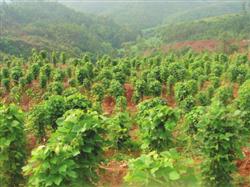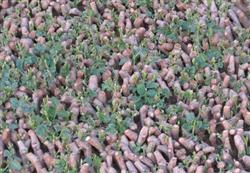What are the management points of planting Pueraria lobata?

What are the management points of planting Pueraria lobata? Please give guidance on the key points of planting kudzu root management can refer to the following methods: first, timely management of vines: strong germination of kudzu, fast growth of kudzu, timely management of vines after setting up frames. Each plant left 2-3 main vines on the shelf, and all the surplus vines were cut off. For the corners with more missing nests, one or two more kudzu can be left, which can be used to press the vines to fill the nests. Remove all the lateral vines within 1 meter from the ground, and pick the heart in time when the height of the kudzu vine reaches 2.5 million 3m, so as to prevent overgrowth. When the main vine is more than 1 meter long, the side vine 20~30cm is coring. Second, loosening the soil and weeding: timely ploughing and loosening the soil, removing weeds and maintaining the good permeability of the soil, which is beneficial to the growth of Pueraria lobata. Third, apply root expansion fertilizer: July to October is the period of rapid expansion of kudzu root, which requires a lot of water and nutrients, timely fertilization and irrigation to promote the expansion of root tuber. The plant is required to apply compound fertilizer 1 / 2, 40~60kg per mu, open nest at the distance from the base of Pueraria lobata to 5cm, and irrigate in time. Fourth, pressing the vine to mend the nest: for the box ridge with more lack of nests, you can choose to leave 1 or 2 main vines not on the shelf, which can be used to press the vine to fill the nest, put the kudzu vine first on the box ridge of the lack of nest, and press the internodes of the missing plant with soil clods. The vines at both ends are cut off after the new roots of the internodes are formed. Fifth, prevention and control of diseases, pests and rats: in the middle and later stages of Pueraria lobata, there is no need to use drugs, but when individual plant diseases and insect pests are serious, there can be no residue and low toxic pesticide control, and combined with agricultural comprehensive measures such as mid-ploughing and weeding, pruning and pruning to eliminate the fallen leaves of withered vines with disease. in the later stage, we should pay attention to prevent rats from gnawing Pueraria lobata. Click to get more Pueraria planting technology click to get more medicinal plant technology
- Prev

What are the propagation methods of Pueraria lobata?
What are the propagation methods of Pueraria lobata? Please introduce the methods of kudzu root propagation, such as striping, cutting, seed, root head and so on. Cuttings, striping and root head propagation are more commonly used. 1, striping propagation: when the summer growth is luxuriant, choose the stout, disease-free and older kudzu vine, every 1-2 nodes, dig the soil under the section.
- Next

What insect pests need to be controlled in planting Pueraria lobata?
What insect pests need to be controlled in planting Pueraria lobata? To plant kudzu root, you need to control the following pests: ⑴ crickets bite seedlings. Prevention and control method: it can be sprayed with 2000 times of dichlorvos EC. The adult ⑵ beetle came out to bite the leaves at night from May to June. The method of prevention and control can be trapped and killed by light.
Related
- Fuxing push coffee new agricultural production and marketing class: lack of small-scale processing plants
- Jujube rice field leisure farm deep ploughing Yilan for five years to create a space for organic food and play
- Nongyu Farm-A trial of organic papaya for brave women with advanced technology
- Four points for attention in the prevention and control of diseases and insect pests of edible fungi
- How to add nutrient solution to Edible Fungi
- Is there any good way to control edible fungus mites?
- Open Inoculation Technology of Edible Fungi
- Is there any clever way to use fertilizer for edible fungus in winter?
- What agents are used to kill the pathogens of edible fungi in the mushroom shed?
- Rapid drying of Edible Fungi

